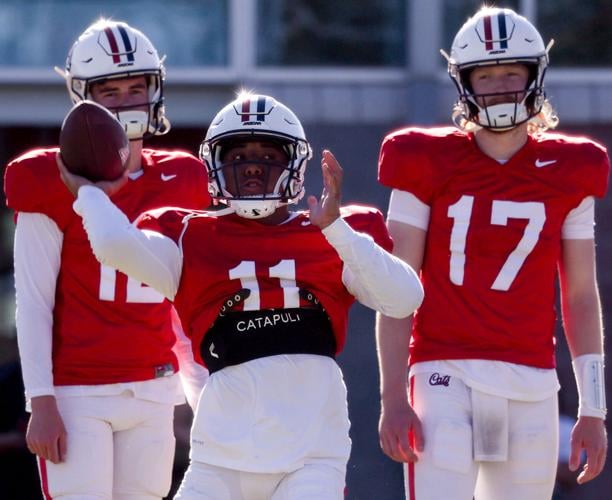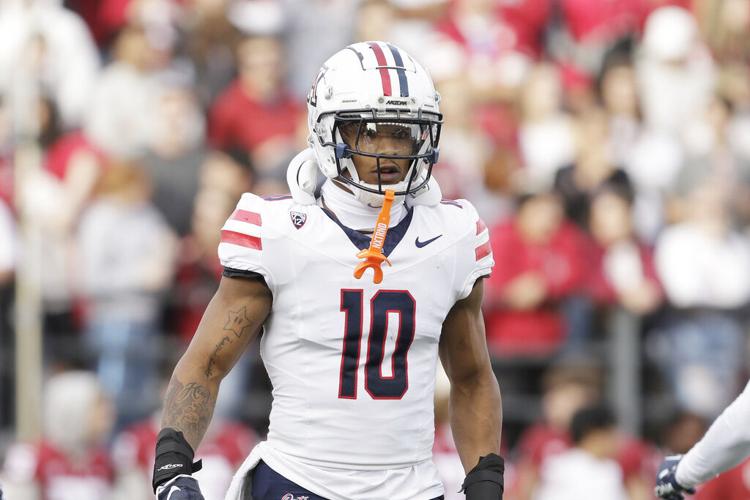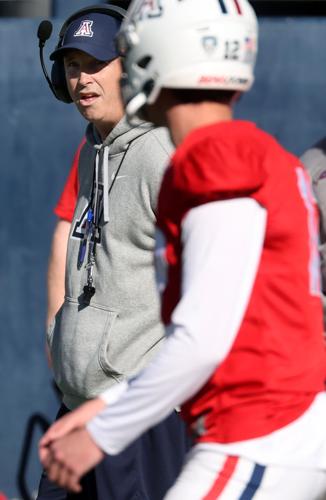College football has never been closer to the NFL than this upcoming season.
Among the laundry list of new elements in the college game, including conference realignment and the expanded 12-team College Football Playoff format, college ball will adopt three items from the NFL for 2024:
- coach-to-player communication in helmets;
- a two-minute warning in the second and fourth quarters;
- sideline video replay by way of tablets. The Big 12 recently announced that it’s partnering with Microsoft to add Windows tablets on the sidelines and coaching boxes during games. The Big Ten, SEC and ACC have a deal with Apple for players and coaches to use iPads.
“We are thrilled to partner with the Big 12 Conference for the (upcoming college football) season as they continue to innovate in football and technology,” said Gabe Rudolph, senior sports partnership manager at Microsoft, in a released statement. “We look forward to bringing our joint expertise together to evolve the game and further empower student-athletes and coaches.”

Arizona QBs Cole Tannenbaum, left, Noah Fifita, middle, and Brayden Dorman, right, participate in throwing drills during a spring football practice on April 23 on the UA campus.
The NFL has included Microsoft tablets on sidelines since 2014, albeit players and coaches are only allowed to look at still images and not videos. College football teams will have the option to look at both images and videos during games. In recent years, high school football teams have used video replay to analyze film on the sidelines.
Arizona head coach Brent Brennan said his plan is for the Wildcats to “practice with (the tablets) as much as we can” during preseason camp.
“We’ve had a lot of conversations with people about how to utilize it or the best practices there, but I think that’s going to be specific for our staff and the value our coaches find in it or able to pull of it and how quickly we can get that stuff integrated in our process,” Brennan said. “College coaches, we’ve been watching high school coaches do it for, shoot, 10 years — maybe more. We’re all excited about it, because of the information you’re getting in real time and be able to provide your players a picture and video of what’s happening in real time.”
The tablets are “going to help us a lot,” Arizona quarterback Noah Fifita said.

First-year Arizona football coach Brent Brennan watches his quarterback corps make some throws as the Wildcats work out during a spring practice session back in April at Arizona Stadium.
“Last year, when you’re on the field, you’re by yourself and I know (wide receiver Tetairoa McMillan) always talked about his first college game, he came off (the field) expecting to go to the iPad and that’s when we found out there’s no iPads,” Fifita said. “Those are beneficial for everybody, but especially when it comes to my position.”
Arizona will also ramp up coach-to-player communication leading up to the season opener against New Mexico on Aug. 31. Each team can have one player on the field with a helmet that’s able to hear coaches; helmets will be marked with a green decal on the back. Every Arizona quarterback in training camp has a green decal on their helmets. During games, communication from the player to coach will be turned off when the ball is snapped or when there are 15 seconds left on the play clock.
“This is all new for the coaches and it’s all new for the players,” Arizona offensive coordinator Dino Babers said. “When I played back in the day, I’m not quite sure I would want my coach talking to me all the way up until the last second when the play is called, because a lot of the times the players are a lot cooler than the coaches in those situations because if you’re playing, you can be cool. As a coach sitting out there, you’re acting like you’re out there. You’re not out there so you gotta let them play.
“I don’t want to take that extra time to talk into his ear. I want him to take the extra time at the line of scrimmage and dissect what’s going on so we can operate,” Babers said.
For Fifita, he prefers “having Coach Babers, being able to talk to him and him telling me what he’s looking for and having him in my ear and being able to confirm things that you saw” instead of the archaic play-calling model that’s been used in college football until this season.
The latest development in college football falls the season after Michigan’s sign-stealing scandal that was orchestrated by former UM staffer Connor Stalions, who was fired midway through last season. Assistant coaches donning different-colored shirts and holding up poster cards with various images for the players to understand a play call in uptempo or no-huddle offenses will no longer be as prominent in college football.
For coaches like Brennan and Babers, who have never coached in the NFL, overcoming the kinks and growing pains leading up to the season is inevitable.
“We’ve gotta work through some things, but I think we’re doing that,” Babers said. “We’re doing a good job in practice pushing the issue.”

Arizona linebacker Justin Flowe stands on the field during the first half of an NCAA college football game against Washington State on Oct. 14, 2023, in Pullman, Washington.
‘Heem’ blitzer
When Arizona linebackers coach and special teams coordinator Danny Gonzales was asked this week about redshirt junior linebacker Justin Flowe’s personality, Gonzales jokingly responded, “Which one?”
“Heem,” a self-created nickname for the extroverted Flowe, is his alter ago.
“That guy is crazy, special and fun,” Gonzales said. “It’s awesome.”
Flowe’s personality is “invaluable, but I think he’s not the only one that makes it special,” Gonzales said.
“He’s very outspoken, he’s very big on social media and those things,” Gonzales said of Flowe, who has over 370,000 followers on Instagram. “If I looked like that, I would be, too. It’s infectious, and I’m glad he’s on our football team.”
Flowe is entering his second season at Arizona — fifth in college football — after spending his first three years at Oregon. Flowe, the 6-2, 220-pound Chino, California native, was a five-star prospect and the top-rated linebacker in 2020, and “has been a very interesting specimen since he was a freshman in high school,” said Gonzales, who tried recruiting him to Arizona State when he was an defensive coordinator in Tempe.
At Oregon, Flowe dealt with a series of injuries and struggled to live up to the lofty expectations he carried with him coming out of Upland High School. Flowe transferred to Arizona last spring and emerged as a run-stopping linebacker and finished the 2023 season with 44 tackles, the sixth-most on the team. However, Flowe’s tendency of getting lost in pass coverage — and freelancing at times — led to inconsistent production from the linebacker, leading to former UA defensive back Martell Irby starting multiple games at linebacker.
Along with sophomores Taye Brown and Kamuela Ka’aihue, Flowe was in the mix to potentially start alongside star linebacker Jacob Manu, who Gonzales called the “the best linebacker in the Big 12, and I’ll say that until I’m blue in the face.”
“There’s (16) other schools or whatever, we have the best linebacker in the Big 12,” Gonzales said.
But Brown edged Flowe and Ka’aihue for the starting job to begin training camp. That doesn’t mean Flowe won’t make an impact in defensive coordinator Duane Akina’s system. Under the new coaching regime, there’s been a rise in blitzing, with Flowe as a noticeable playmaker at the line of scrimmage and creatively rushing the quarterback. Flowe’s explosive tackling and freakish athleticism could give him a niche role as a pass-rushing linebacker, a similar role to Micah Parsons for the Dallas Cowboys.
“He’s not Micah Parsons so don’t put that label on anybody,” Gonzales said. “You can do that with multiple players. We have several packages because of that. (Safety) Dalton Johnson, you can put him at ‘Will’ linebacker. He’s smart enough to know it.”
Since Gonzales was hired at Arizona, Flowe has “made it a priority to be good in school, he’s made it a priority to stay out of trouble off the field and has made it a priority to be good at football.”
Being among the top contributors on “all four special teams” will also be expected of Flowe.
“How much he plays next to Manu will determine what trust he earns amongst the coaches and teammates,” Gonzales said. “Knowing what to do and how to do it is the most important piece to this, and that’s where he’ll fit.”
Extra points
- In Arizona’s third training camp session on Friday at Arizona Stadium, Ka’aihue recorded a fumble recovery and tackle for loss and intercepted a pass thrown by Fifita.
- Redshirt junior guard Leif Magnuson didn’t practice and was replaced by Northwestern transfer Alexander Doost in the starting lineup. Arizona’s starting offensive line had left tackle Rhino Tapa’atoutai, New Mexico transfer Shancco Matautia at left guard, center Josh Baker, Doost and right tackle Jonah Savaiinaea.
- Scouts from the Jacksonville Jaguars, Miami Dolphins, Denver Broncos and Minnesota Vikings were in attendance for Friday’s practice.






